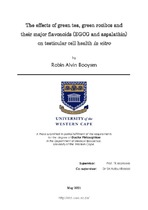| dc.contributor.advisor | Monsees, Thomas | |
| dc.contributor.author | Booysen, Robin Alvin | |
| dc.date.accessioned | 2022-01-25T08:39:51Z | |
| dc.date.available | 2022-01-25T08:39:51Z | |
| dc.date.issued | 2021 | |
| dc.identifier.uri | http://hdl.handle.net/11394/8650 | |
| dc.description | Philosophiae Doctor - PhD | en_US |
| dc.description.abstract | The testes play a central role in the male reproductive system, as they represent the sites of male sex steroidogenesis and of spermatogenesis. Leydig cells, located at the testicular interstitium, produce predominantly testosterone upon stimulation with either chorionic gonadotropin (CG) or luteinising hormone by a series of enzymatic modifications of cholesterol. Sertoli cells respond to testosterone and follicle stimulating hormone to secrete inhibin and facilitate spermatogenesis by additional activities like maintaining Sertoli cell barrier (SCB) integrity and lactate secretion. Ultimately the Leydig cells, Sertoli cells etc. all work together to confer male fertility. However, infertility occurs globally; leading to the pursuit of treatment, including herbal medicines. | en_US |
| dc.language.iso | en | en_US |
| dc.publisher | University of Western Cape | en_US |
| dc.subject | Green tea | en_US |
| dc.subject | Green rooibos | en_US |
| dc.subject | Leydig cell | en_US |
| dc.subject | Energy metabolism | en_US |
| dc.subject | Steroidogenesis | en_US |
| dc.title | The effects of green tea, green rooibos and their major flavonoids (EGCG and aspalathin) on testicular cell health in vitro | en_US |
| dc.rights.holder | University of Western Cape | en_US |

